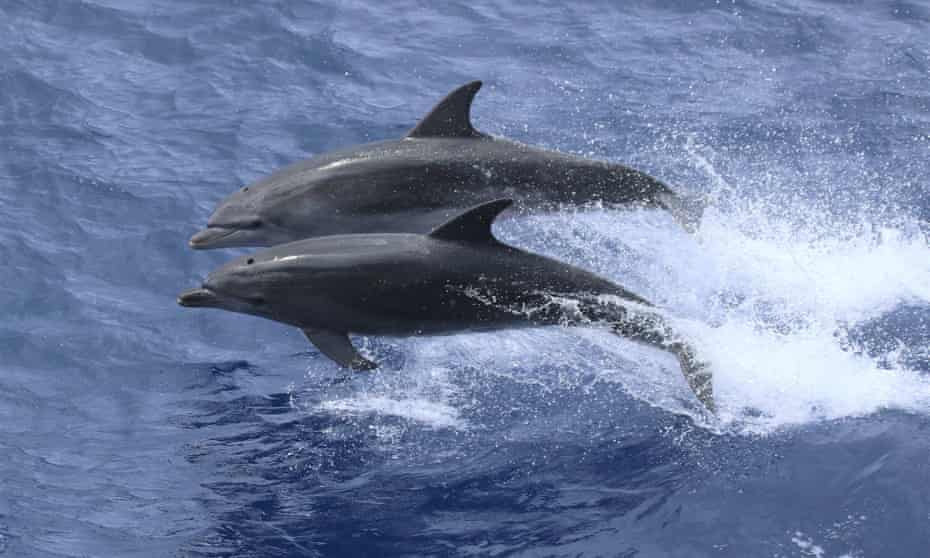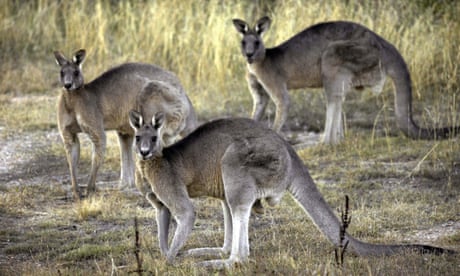AUSTRALIA
Bottlenose dolphins being caught and killed in WA trawl nets at ‘unsustainable’ levelsBetween 11 and 17 dolphins killed each year, government says, though independent observers put rate as high as 50 a year

Bottlenose dolphins in Western Australia are being killed at unsustainable levels after being caught in trawl nets, a new study says. Photograph: Andy Schofield/RSPB/PA
Australian Associated Press
Australian Associated Press
Fri 29 Apr 2022
Bottlenose dolphins are being caught and killed in trawl nets in Western Australia’s north at unsustainable levels, a study warns.
The finding is based on analysis of the Pilbara trawl which supplies fish to the Perth market, targeting emperor, snapper, trevally, cod and grouper.
A report last year by the federal environment department indicated between 11 and 17 bottlenose dolphins were killed every year in the trawl’s bycatch.
Independent observers have previously put the rate as high as 50 a year in peer-reviewed research.
In a new international study published in the Conservation Biology journal, researchers used a modelling tool incorporating chance events to assess population declines among bottlenose dolphins in the Pilbara.

Large kangaroo kicks woman to the ground in unprovoked attack on Gold Coast golf course
Read more
Dr Simon Allen, an adjunct research fellow at the University of Western Australia, said the study found capture rates remained unsustainable even with mitigation efforts.
“Bycatch reduction devices were placed in the trawl nets in 2006 and there has been some monitoring since, but no quantitative assessment of the impact of fishery-related dolphin mortality was ever carried out,” Allen said.
“We set out to model different levels of dolphin capture, including those reported in fishers’ logbooks and those reported by independent observers.
“Unfortunately, our results show clearly that even the lowest reported annual dolphin capture rates are not sustainable.”
Previous models had focused simply on the maximum number of marine animals that could be killed without affecting the sustainability of the population.
The new study takes into account environmental and demographic factors, including the dependency of offspring on their mothers and chance events such as heatwaves.
It found the “acceptable” number of bottlenose dolphin bycatch deaths was between two and eight a year, compared to 16 under the less-sophisticated model.
“These results suggest that reported bycatch rates are unsustainable in the long term, unless reproductive rates are consistently higher than average,” the authors found.
WA’s primary industries department is required to publish an ecological risk assessment of the Pilbara trawl by December this year.
In a report last year, the federal environment department said there were only two vessels operating in the fishery and the risk to sustainability was generally considered to be low.
But the report said there were still “relatively large” numbers of dolphins and critically endangered green sawfish being killed every year.
“The vulnerable nature of such species suggests that any interactions are potentially significant,” it said.
“Efforts to lower the number of TEPS (threatened, endangered and protected species) interactions and mortalities should continue.”
Research has indicated the bottlenose dolphin population in the Pilbara may be distinct from other populations, leaving it particularly vulnerable to fishing-related deaths.
Bottlenose dolphins are being caught and killed in trawl nets in Western Australia’s north at unsustainable levels, a study warns.
The finding is based on analysis of the Pilbara trawl which supplies fish to the Perth market, targeting emperor, snapper, trevally, cod and grouper.
A report last year by the federal environment department indicated between 11 and 17 bottlenose dolphins were killed every year in the trawl’s bycatch.
Independent observers have previously put the rate as high as 50 a year in peer-reviewed research.
In a new international study published in the Conservation Biology journal, researchers used a modelling tool incorporating chance events to assess population declines among bottlenose dolphins in the Pilbara.

Large kangaroo kicks woman to the ground in unprovoked attack on Gold Coast golf course
Read more
Dr Simon Allen, an adjunct research fellow at the University of Western Australia, said the study found capture rates remained unsustainable even with mitigation efforts.
“Bycatch reduction devices were placed in the trawl nets in 2006 and there has been some monitoring since, but no quantitative assessment of the impact of fishery-related dolphin mortality was ever carried out,” Allen said.
“We set out to model different levels of dolphin capture, including those reported in fishers’ logbooks and those reported by independent observers.
“Unfortunately, our results show clearly that even the lowest reported annual dolphin capture rates are not sustainable.”
Previous models had focused simply on the maximum number of marine animals that could be killed without affecting the sustainability of the population.
The new study takes into account environmental and demographic factors, including the dependency of offspring on their mothers and chance events such as heatwaves.
It found the “acceptable” number of bottlenose dolphin bycatch deaths was between two and eight a year, compared to 16 under the less-sophisticated model.
“These results suggest that reported bycatch rates are unsustainable in the long term, unless reproductive rates are consistently higher than average,” the authors found.
WA’s primary industries department is required to publish an ecological risk assessment of the Pilbara trawl by December this year.
In a report last year, the federal environment department said there were only two vessels operating in the fishery and the risk to sustainability was generally considered to be low.
But the report said there were still “relatively large” numbers of dolphins and critically endangered green sawfish being killed every year.
“The vulnerable nature of such species suggests that any interactions are potentially significant,” it said.
“Efforts to lower the number of TEPS (threatened, endangered and protected species) interactions and mortalities should continue.”
Research has indicated the bottlenose dolphin population in the Pilbara may be distinct from other populations, leaving it particularly vulnerable to fishing-related deaths.
No comments:
Post a Comment